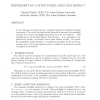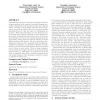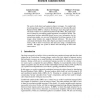1826 search results - page 14 / 366 » Using Random Forests in the Structured Language Model |
ACL
1997
13 years 10 months ago
1997
A new language model for speech recognition inspired by linguistic analysis is presented. The model develops hidden hierarchical structure incrementally and uses it to extract mea...
SCAM
2008
IEEE
14 years 3 months ago
2008
IEEE
An appropriate translation of the data model is central to any language migration effort. Finding a mapping between original and target data models may be challenging for legacy l...
KDD
2008
ACM
14 years 9 months ago
2008
ACM
Discriminative training for structured outputs has found increasing applications in areas such as natural language processing, bioinformatics, information retrieval, and computer ...
BMCBI
2005
13 years 8 months ago
2005
Background: Phages, viruses that infect prokaryotes, are the most abundant microbes in the world. A major limitation to studying these viruses is the difficulty of cultivating the...
NIPS
2004
13 years 10 months ago
2004
We seek to both detect and segment objects in images. To exploit both local image data as well as contextual information, we introduce Boosted Random Fields (BRFs), which use boos...



